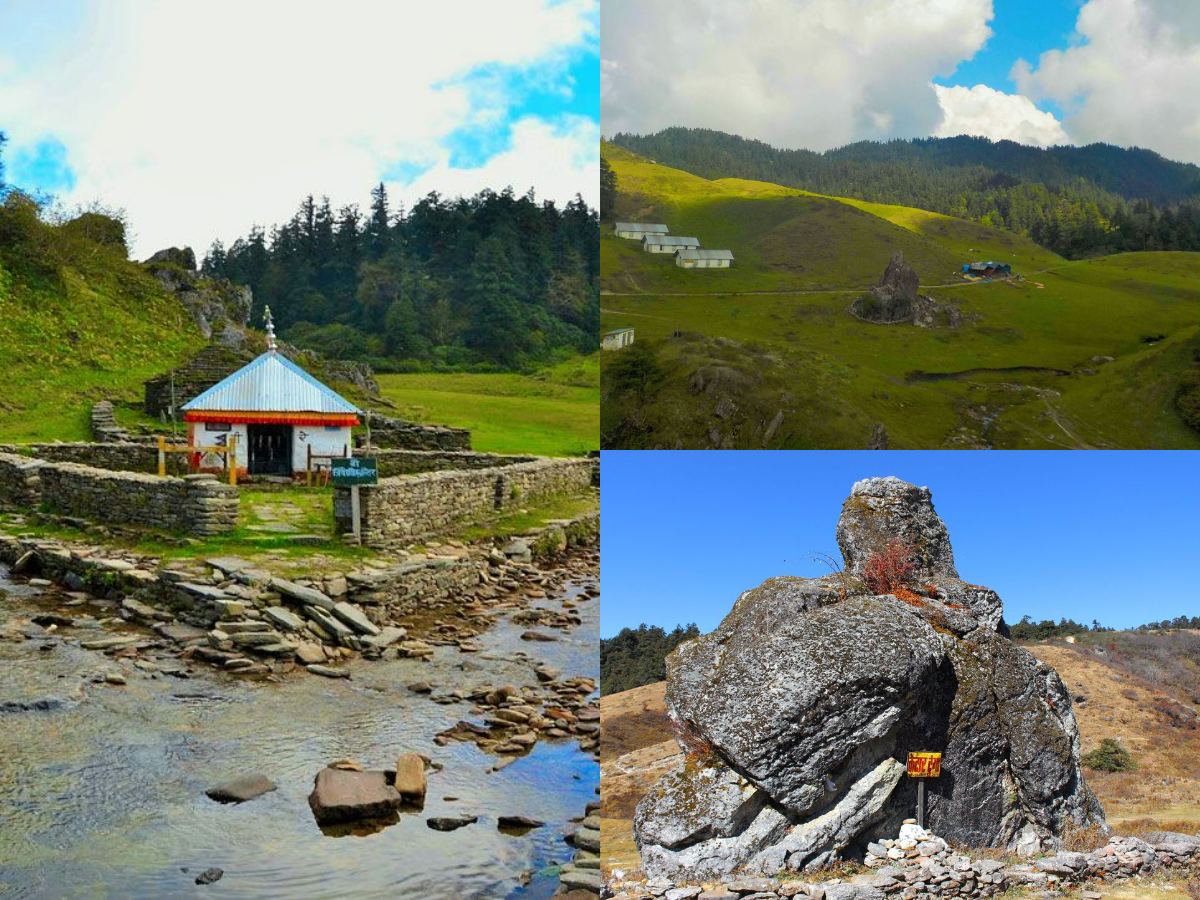Khaptad National Park (Nepali: खप्तड राष्ट्रिय निकुज), the home of the renowned scholar and a hermit Late Khaptad Swami (खप्तड स्वामी), was established as a national park in 1984 AD. It covers an area of 225 sq. km and has a buffer zone of area 216 sq. km.
Since 1940’s Khaptad Swami aka Khaptad Baba (खप्तड बाबा), spent his 50 years in Khaptad performing meditation and worshiping. After the enlightenment Khaptad Baba was known as Swami Sachidananda (स्वामी सच्चिदानन्द) representing “existing, conscious and blissful”. The mind-mountains of this national park are full of medicinal herbal plants.
Identifying some of medicinal plants Khaptad Baba showed himself as not only the spiritual saint but a research scholar too. Being the domicile of Khaptad Baba this place is not only biological importance but of great religious importance too. This area is full of natural diversities along with peace and tranquility.
Location:
Khaptad National Park is located in the Sudurpashchim Province of Nepal at the corona of Doti, Bajura, Bajhang and Achham districts. The map coordinates are 29°16’12”N 80°59’24”E. It is 446 km aerial distance away from Kathmandu, Nepal.
Key features of Khaptad National Park:
- The religious site Trebeni Ghat (त्रिवेणी घाट) lies on the way to park headquarter. The Ghat is confluence of green hills and the rivers belonging to Khaptad National Park. The Ashram (hermitage) of Khaptad Baba is located in Tribeni. The lower Trebeni, consisting of temples, is an area of meditation. There is no restriction for the visitor. The exceptions are restriction on cutting woods, grazing animals, smoking, drinking alcohols and slaughtering animals.
- The spring season (March to May) and autumn season (October to November) are considered the best to visit this national park. During this time the weather remains clean, the temperature remains clam and the environment remains clean, the temperature ranges from 10 °C to 20 °C. From June the monsoon begins and continues until the end of September which makes the region muddy, wet and slippery. The winter persists from December to February when snowfall happens with the blow of chilling wind.
- The park consists of rolling hills of grasslands and forests of subalpine, temperate and subtropical vegetation. It has an extraordinary ecosystem. Also there are gorges and mind-elevation plateaus.
- The subtropical forest in lower altitude is occupied with Chir pine trees and the sub alpine forest in high altitude consists of rhododendron, fir, oak, bamboo, hemlock tress and smaller shrubs. The middle hills are filled with conifer and board leaf plants.
- So far 224 species of medicinal herbs have been identified in this living garden of medicinal herbs.
- It’s habitat of 270 species of birds. Hence it’s an excellent birding place. Some of the common birds are Impeyan Pheasant (Danphe; national bird of Nepal), peregrine falcon, flycatchers, partridges, eagles, white vulture, cuckoons and bulbuls.
- Khaptad National Park harbors 567 species of flowering plants which is 11 % of total flowering plants found in Nepal.
- Some common faunas found in the national park are Himalayan black bear, barking deer, yellow-throated marten, ghoral, rhesus monkey, wild boar, langur monkey and wild dog.
- The park is full of spiritual vibes so sets in a heart of those wanting to escape from mundane life to the lap of pristine nature. Visitors choose this place for yoga, meditation, trekking, jungle walk and religious performance.
- The religious sites present in the park are Sahashra Linga (सहश्र लिङ्ग), Ganesh Temple (गणेश मन्दिर), Kedar Dhunga (केदार ढुङ्गा) and Naag Dhunga (नाग ढुङ्गा). The Sahashra Linga is also the highest elevation on the park with an altitude of 3200 m. One the day of Jestha Purnima (जेष्ठ पूर्णिमा) in each year there held the Ganga Dashahara (गङ्गा दशहरा)
- There is a serene Khaptad Daha (खप्तड दह) aka Khaptad Lake in the northeast where occurs a festival in every August and September. Hindu pilgrims worship the lord Shiva; the god of rest of the gods and goddesses. So visiting this place is a chance to enjoy a native cultural experience. Alcohol, tobacco and butchering are not allowed in this place.
- Beside Khaptad Lake, the spectacular view of Api (अपि) and Saipal (सैपाल) Mountain Ranges are seen from the park. Those all are the places of special interest for the visitors/tourists.
- Another popular destination Ramaroshan (रामारोसन) is located near the Khaptad in Achham district. In Hindu scriptures it is called Pancha Pura (पञ्चपुर: five cities). Ramaroshan area consists of 12 small lakes and 18 green pastures aka patans. The apex each Patan(पाटन, pastureland) is the view point of Api, Saipal and Malika (मालीका) In summer the locals visit the Patans to graze their livestock. The northern part consists of series of sedimentary rocks.
- Silgadhi (सिलगढी) Bazar in Doti district is known as the gateway to Khaptad National Park. It is 50 km away from the park headquarters and requires 2 days trek to reach there. The public buses leave from Kathmandu to Attariya (अत्तरिया) Chowk in Kailali district. Silgadhi Bazaar is 9 hours driving distance away from Attariya Chowk. Alternatively, a direct flight from Kathmandu to Dhangadhi (धनगढी) followed by a drive from Dhangadhi to Silgadhi Bazaar is the next option. While visiting from India, the Mahendranagar (महेन्द्रनगर) city of Nepal is a 30 minutes driving distance away from Banbasa, India. From Mahendranagar the Silgadhi Bazaar is 10 hours driving distance away.
- For trekkers the best itinerary is: flight Kathmandu-Nepalgunj, Drive Nepalgunj-Buditola, drive Buditola-Silgadhi, trek Silgadhi-Khaptad, trek Khaptad-Silgadhi, drive Silgadhi-Dhangadhi and then fly Dhanghadi-Kathmandu.
Additional Information
Activities: Trekking
Accommodation: Camping
Access: Fly from Kathmandu-Nepalgunj (55 min.), then fly to Chainpur (Bajhang) 20 min and then walk for three days. Alternatively, fly Kathmandu-Dhanghadi (1 hr. 5 min.) or drive 670 km. Then drive 10 hours to Silgadhi and then trek for one day.
Best Season: Mar-May and Oct-Nov (10-20 °C), Jun-Sep (rainy), Dec-Feb (Snow)
Park Headquarter: Khaptad
